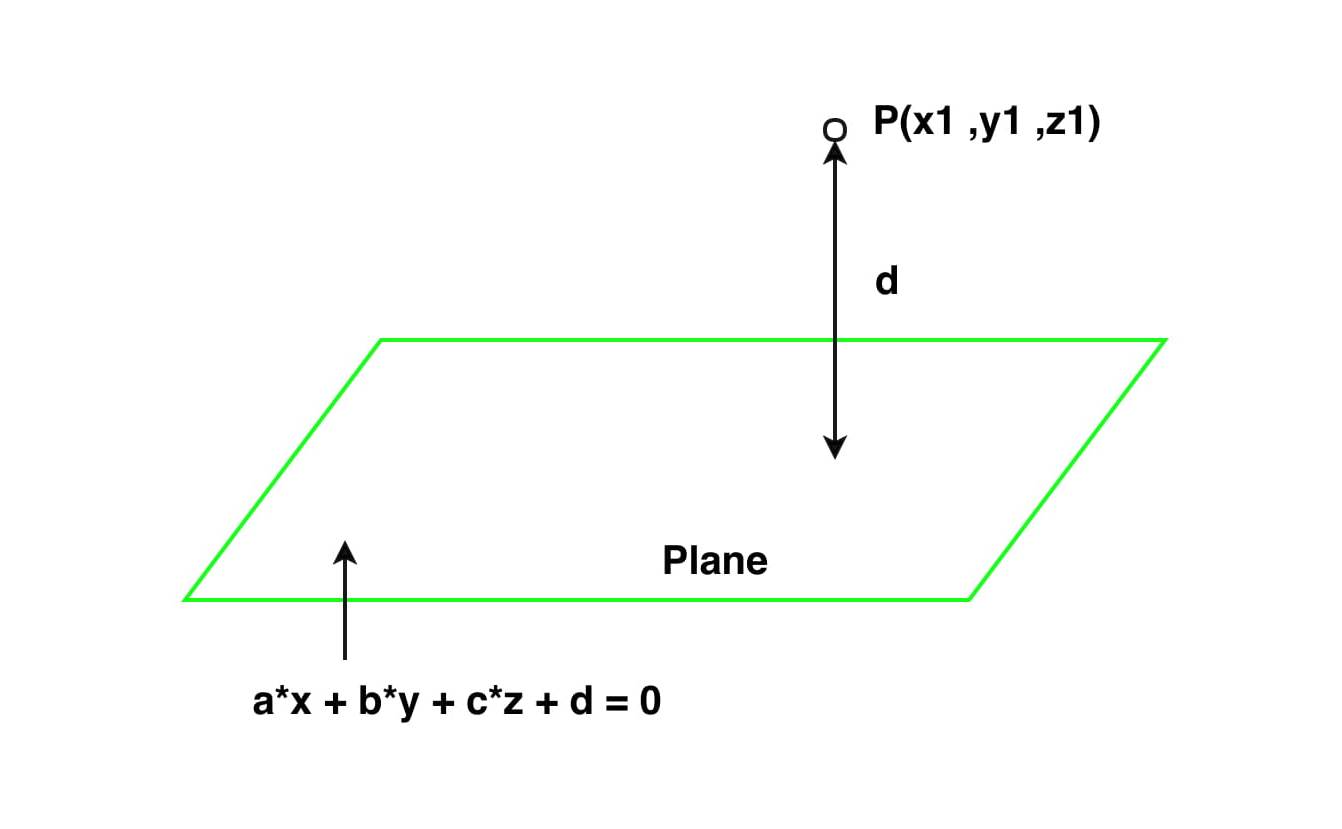Distance between a point and a Plane in 3 D
Last Updated :
29 Sep, 2022
You are given a points (x1, y1, z1) and a plane a * x + b * y + c * z + d = 0. The task is to find the perpendicular(shortest) distance between that point and the given Plane.

Examples :
Input: x1 = 4, y1 = -4, z1 = 3, a = 2, b = -2, c = 5, d = 8
Output: Perpendicular distance is 6.78902858227
Input: x1 = 2, y1 = 8, z1 = 5, a = 1, b = -2, c = -2, d = -1
Output: Perpendicular distance is 8.33333333333
Approach: The perpendicular distance (i.e shortest distance) from a given point to a Plane is the perpendicular distance from that point to the given plane. Let the co-ordinate of the given point be (x1, y1, z1)
and equation of the plane be given by the equation a * x + b * y + c * z + d = 0, where a, b and c are real constants.
The formula for distance between a point and Plane in 3-D is given by:
Distance = (| a*x1 + b*y1 + c*z1 + d |) / (sqrt( a*a + b*b + c*c))
Below is the implementation of the above formulae:
C++
#include<bits/stdc++.h>
#include<math.h>
using namespace std;
void shortest_distance(float x1, float y1,
float z1, float a,
float b, float c,
float d)
{
d = fabs((a * x1 + b * y1 +
c * z1 + d));
float e = sqrt(a * a + b *
b + c * c);
cout << "Perpendicular distance is "
<< (d / e);
return;
}
int main()
{
float x1 = 4;
float y1 = -4;
float z1 = 3;
float a = 2;
float b = -2;
float c = 5;
float d = 8;
shortest_distance(x1, y1, z1,
a, b, c, d);
}
|
C
#include<stdio.h>
#include<math.h>
void shortest_distance(float x1, float y1, float z1,
float a, float b, float c, float d)
{
d = fabs((a * x1 + b * y1 + c * z1 + d));
float e = sqrt(a * a + b * b + c * c);
printf("Perpendicular distance is %f", d/e);
return;
}
int main()
{
float x1 = 4;
float y1 = -4;
float z1 = 3;
float a = 2;
float b = -2;
float c = 5;
float d = 8;
shortest_distance(x1, y1, z1, a, b, c, d);
}
|
Java
import java .io.*;
class GFG
{
static void shortest_distance(float x1, float y1,
float z1, float a,
float b, float c,
float d)
{
d = Math.abs((a * x1 + b *
y1 + c * z1 + d));
float e = (float)Math.sqrt(a * a + b *
b + c * c);
System.out.println("Perpendicular distance " +
"is " + d / e);
}
public static void main(String[] args)
{
float x1 = 4;
float y1 = -4;
float z1 = 3;
float a = 2;
float b = -2;
float c = 5;
float d = 8;
shortest_distance(x1, y1, z1,
a, b, c, d);
}
}
|
Python
import math
def shortest_distance(x1, y1, z1, a, b, c, d):
d = abs((a * x1 + b * y1 + c * z1 + d))
e = (math.sqrt(a * a + b * b + c * c))
print("Perpendicular distance is", d/e)
x1 = 4
y1 = -4
z1 = 3
a = 2
b = -2
c = 5
d = 8
shortest_distance(x1, y1, z1, a, b, c, d)
|
C#
using System;
class GFG
{
static void shortest_distance(float x1, float y1,
float z1, float a,
float b, float c,
float d)
{
d = Math.Abs((a * x1 + b *
y1 + c * z1 + d));
float e = (float)Math.Sqrt(a * a + b *
b + c * c);
Console.Write("Perpendicular distance " +
"is " + d / e);
}
public static void Main()
{
float x1 = 4;
float y1 = -4;
float z1 = 3;
float a = 2;
float b = -2;
float c = 5;
float d = 8;
shortest_distance(x1, y1, z1,
a, b, c, d);
}
}
|
PHP
<?php
function shortest_distance($x1, $y1, $z1,
$a, $b, $c, $d)
{
$d = abs(($a * $x1 + $b * $y1 +
$c * $z1 + $d));
$e = sqrt($a * $a + $b *
$b + $c * $c);
echo "Perpendicular distance is ". $d / $e;
}
$x1 = 4;
$y1 = -4;
$z1 = 3;
$a = 2;
$b = -2;
$c = 5;
$d = 8;
shortest_distance($x1, $y1, $z1,
$a, $b, $c, $d);
?>
|
Javascript
<script>
function shortest_distance( x1, y1, z1, a,
b, c, d)
{
d = Math.abs((a * x1 + b * y1 +
c * z1 + d));
let e = Math.sqrt(a * a + b *
b + c * c);
document.write("Perpendicular distance is "
+ (d / e));
return;
}
let x1 = 4;
let y1 = -4;
let z1 = 3;
let a = 2;
let b = -2;
let c = 5;
let d = 8;
shortest_distance(x1, y1, z1,
a, b, c, d);
</script>
|
Output:
Perpendicular distance is 6.78902858227
Time complexity: O(log(a2+b2+c2)) as inbuilt sqrt function is being used
Auxiliary space: O(1)
Share your thoughts in the comments
Please Login to comment...